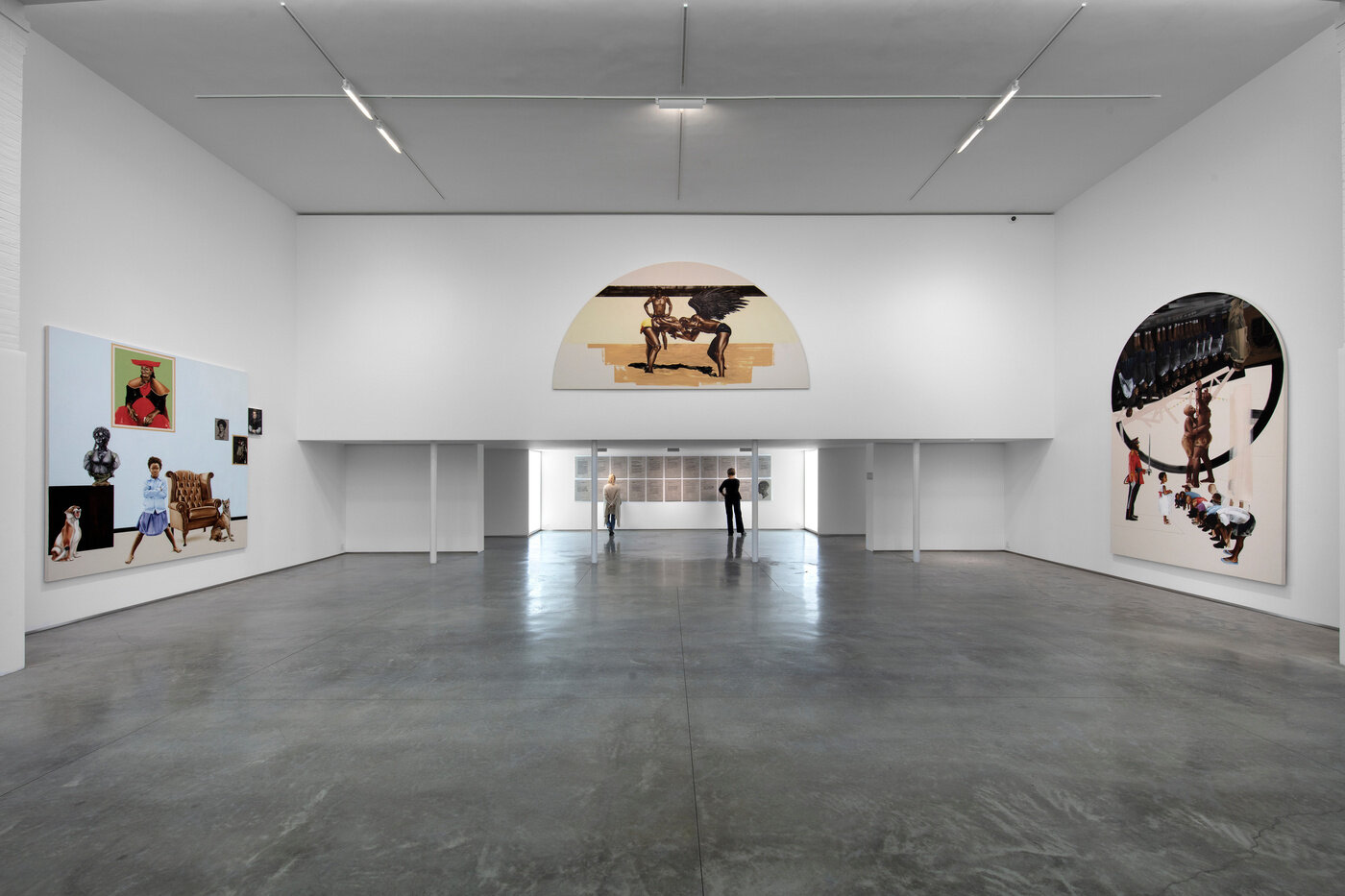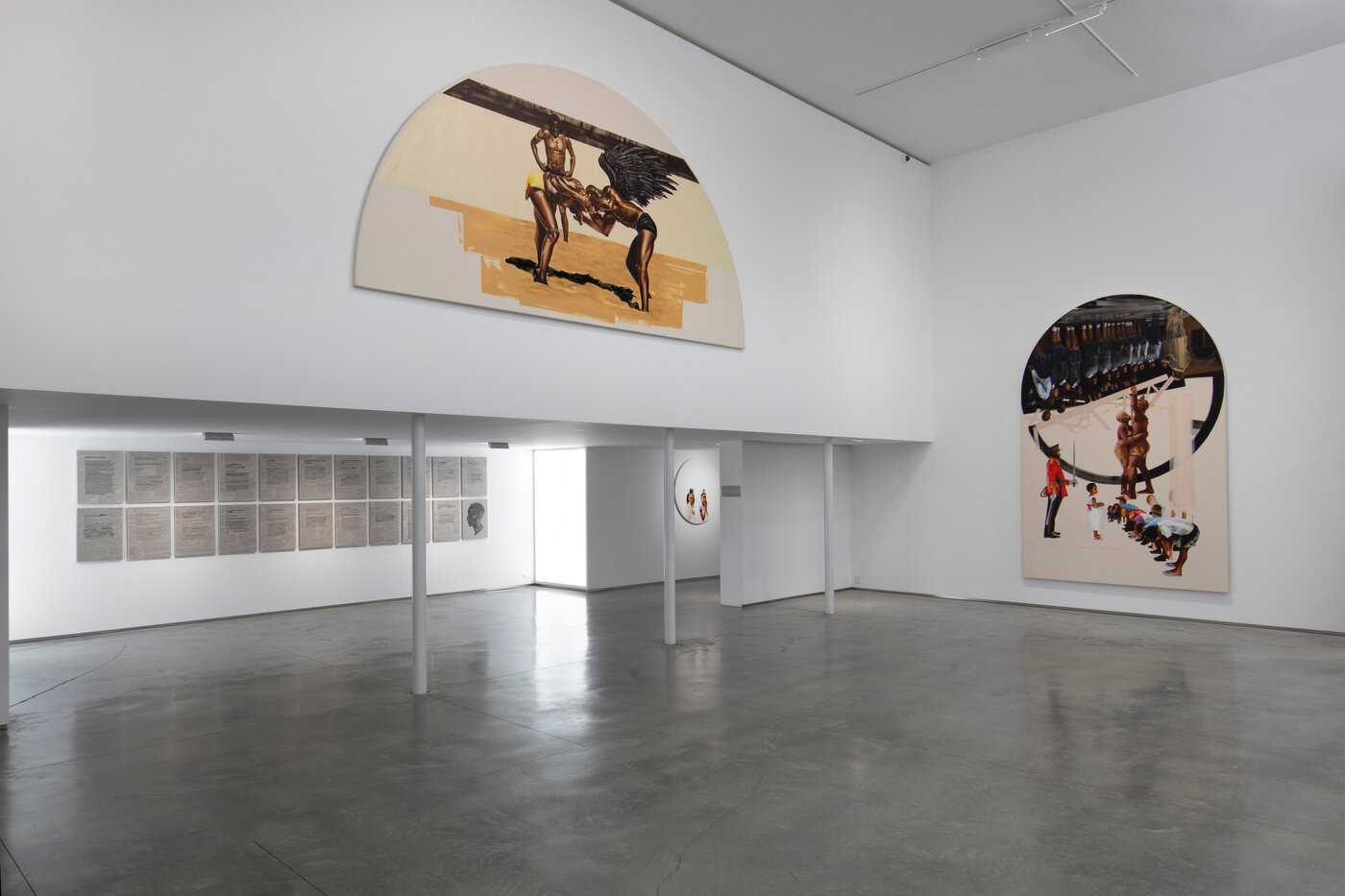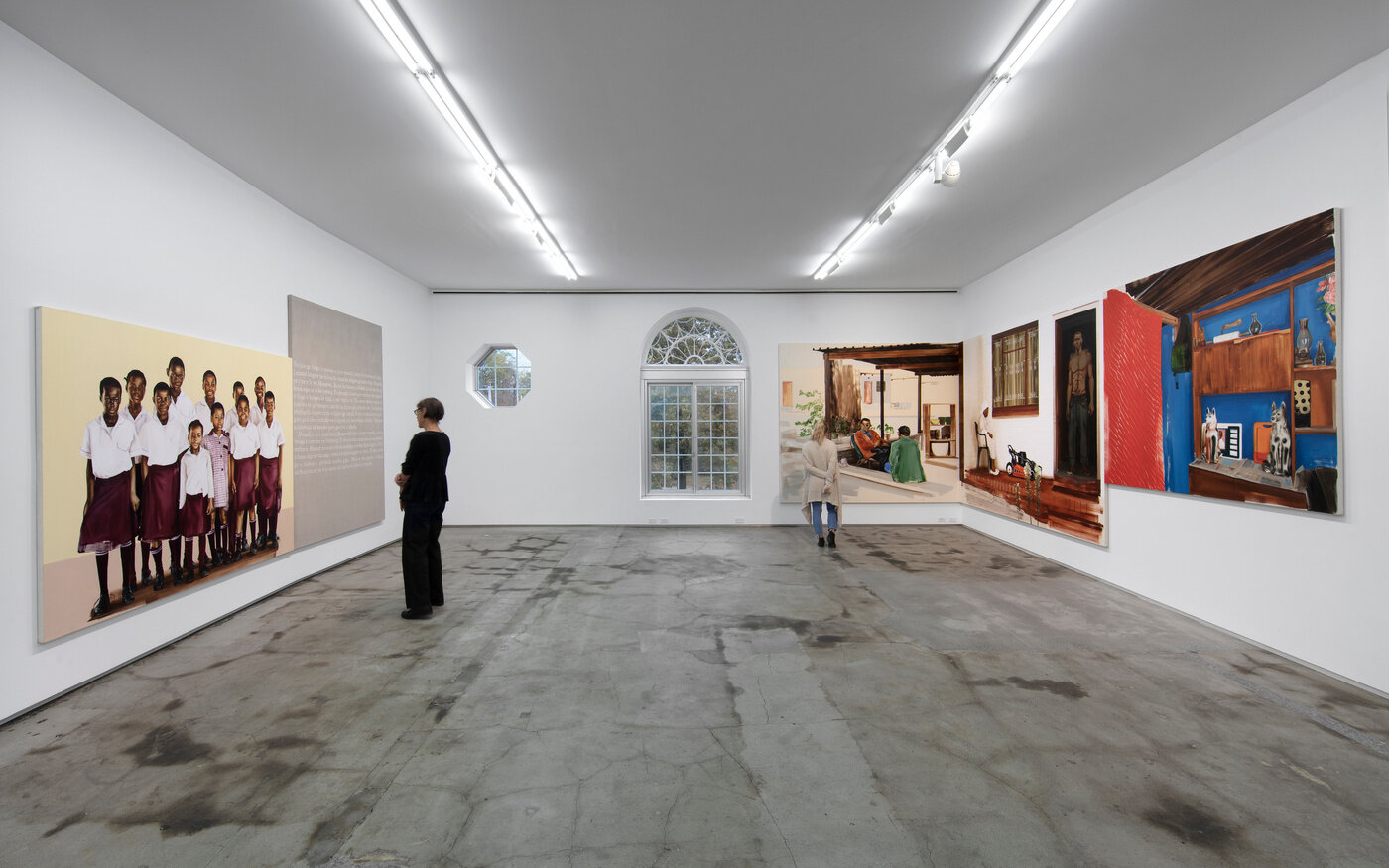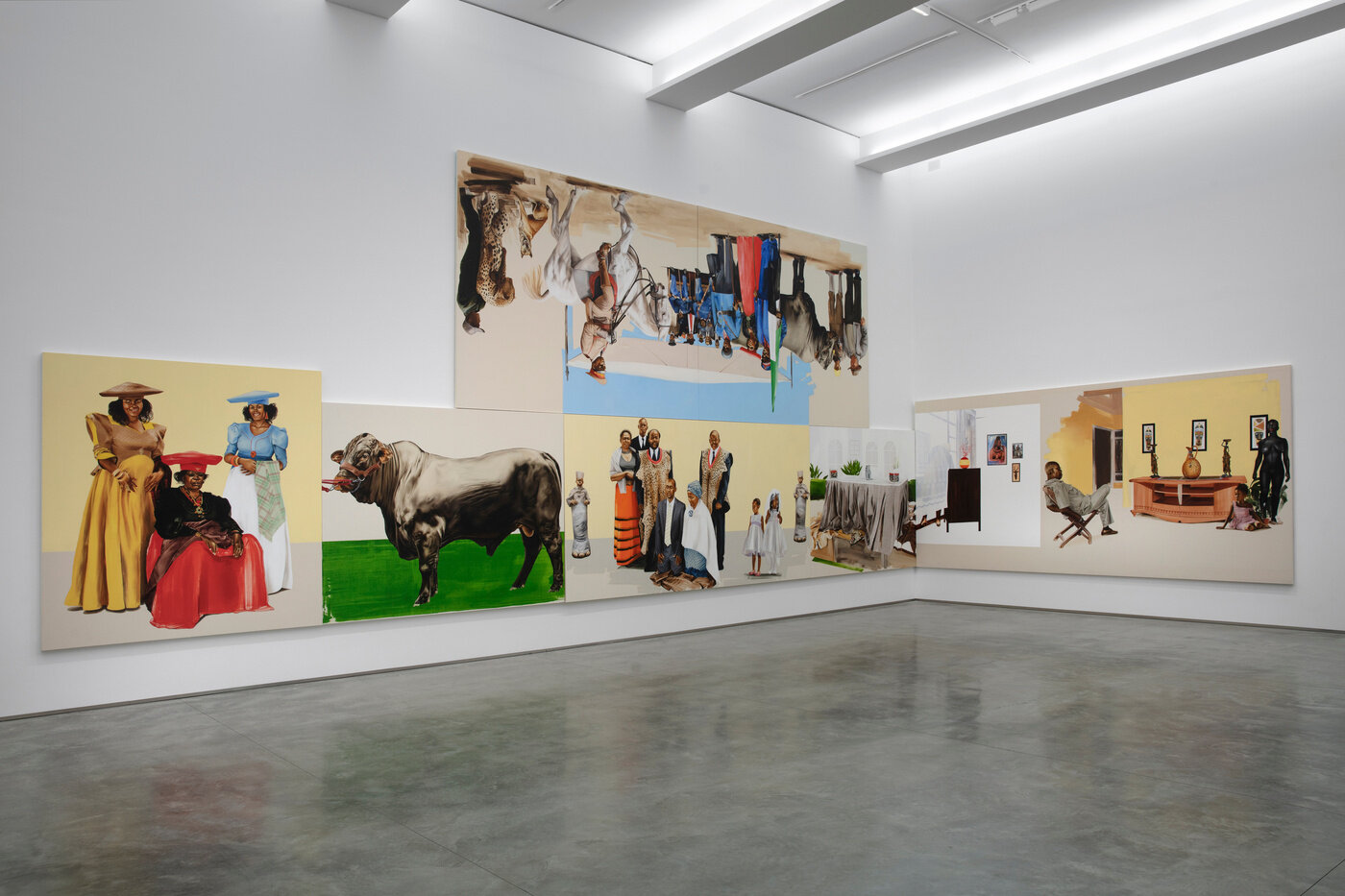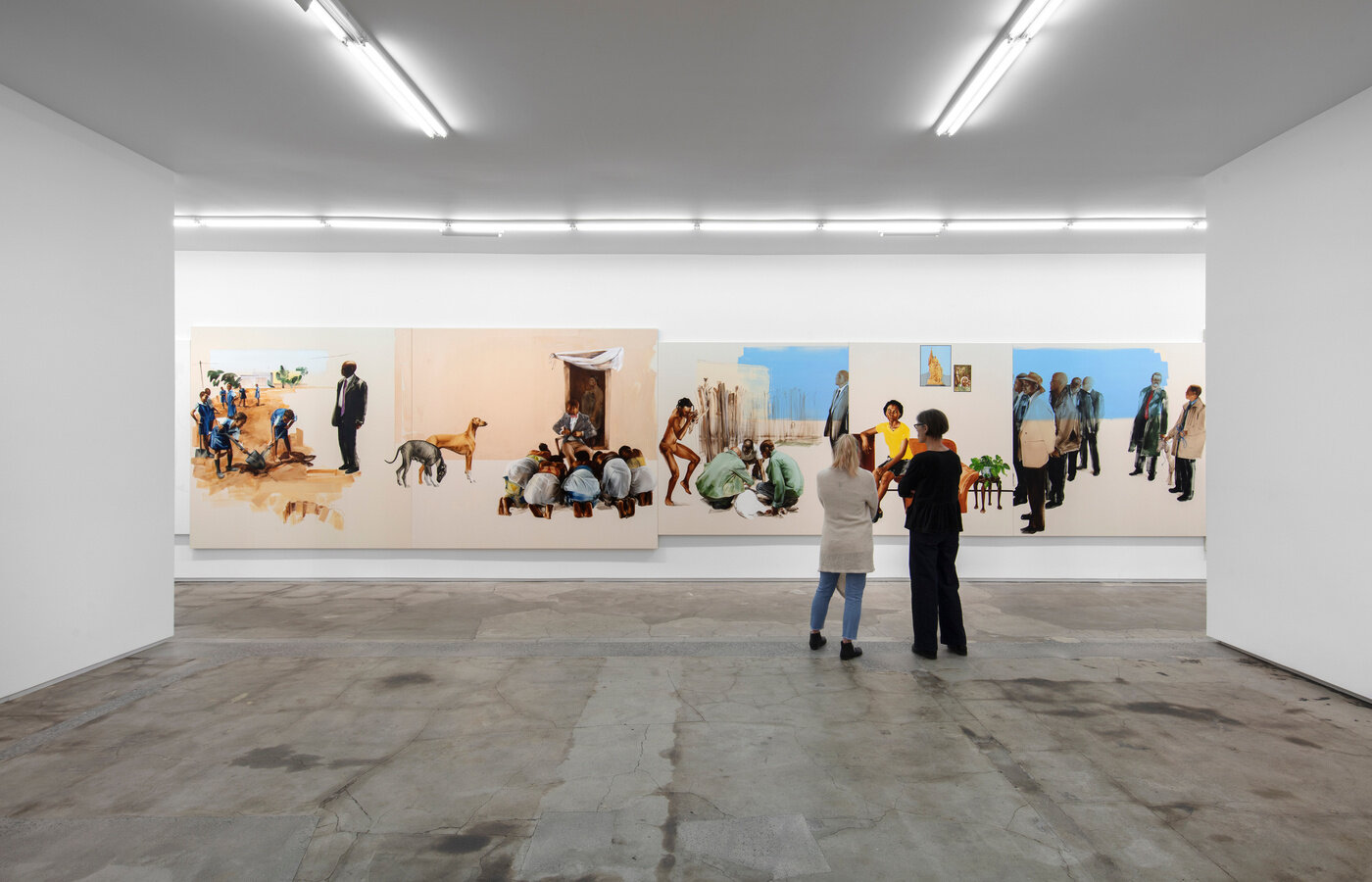Meleko Mokgosi: Democratic Intuition
Works (Tap to zoom)
Press Release
MELEKO MOKGOSI
Democratic Intuition
The School | 25 Broad Street, Kinderhook, NY
October 26, 2019 – March 2020
Jack Shainman Gallery is proud to present Meleko Mokgosi: Democratic Intuition at Jack Shainman Gallery | The School. Democratic Intuition (2013-2019) is an eight-chapter project that questions conceptions of democracy in relation to the daily lived experiences of southern Africans. Mokgosi examines the ways in which democracy can be thought of as inscribed in the individual by various institutions and through processes of socialization and intersubjective exchange. As a result, the project reveals the inherent contradiction between one’s supposed individual freedoms and the necessary recognition of and interaction with the other in democracy.
This exhibition brings together works from seven of the eight chapters of the project (Exordium; Comrades; Lerato; Lex; Acts of Resistance; Objects of Desire; and Chimurenga) in a unique opportunity to view the progression of Mokgosi’s contemplation and investigation of democratic ideals. The content of the work is based on images of southern African life, art history, and the artist’s extensive research. Influenced by cinematic theory, Mokgosi storyboards each chapter and installs his canvases to mimic the filmstrip, creating narrative juxtapositions that communicate and complicate meaning. Drawing from history painting and propaganda, Mokgosi includes iconographic details in his compositions that may not be recognized or understood by a Western audience. By combining broadly legible themes with pointed, specific imagery, Mokgosi encourages a desire in the viewer to understand a history beyond what is already known.
In addition to his choice of imagery, a reconsideration of the technique of painting itself is central to Mokgosi’s work. In choosing a highly realistic style, he points to pre-photographic celebrations of painting that equated mastery with an ability to convincingly portray the world, as well as to the twentieth century’s adoption of realism for political propaganda and advertising. In some panels, passages of striking realism are surrounded by seemingly unfinished areas where the canvas was primed with clear gesso. Beyond calling attention to the fact that these images were not generated from a literal or symbolic white background, these glimpses of beige canvas disrupt any sense of illusionism and acknowledge the limits of all pictures in fully representing our world and ourselves.
Painting large-scale canvases in a style deliberately reminiscent of European history painting allows Mokgosi to subvert colonial-era narratives in subtle and powerful ways by using the language of a grand European tradition to tell the broad story of postcolonial southern Africa. As the championed genre and the standard by which early modern society understood its ideals in images, history painting in Europe was a summation of western moral and aesthetic principles. These ideals included knowledge, reason, and honor, but also bellicosity, elite sovereignty, white supremacy, and the patriarchy. Strategically used by and for European imperialism, it is a genre that Mokgosi has reinvented to tell an alternate history. In the chapters Objects of Desire and Chimurenga (2019) Mokgosi has chosen to reinterpret a historically lower genre of painting – the still life – to explore the contemporary African object, given its legacy as a tool for the Modernists.
The chapter Acts of Resistance (2018) was created in dialogue with paintings in the Baltimore Museum of Art’s permanent collection. These works confront the politics and histories of representation in an effort to examine formal and informal systems of resistance and decolonial practices. This chapter’s central aim is to compel viewers to consider the African subject with more complexity by creating opportunities for nuanced contemplation of representational strategies. From a Euro-centric perspective, black figures are almost always interpreted as representing difference, seen as an exception to the “normal” array of white-skinned figures who dominate not only artwork but positions of political and economic privilege. The figures presented in this chapter seek to transcend generalization and marginalization through their beautiful and precisely rendered attributes, emotions, interrelationships, and geographically specific contexts.
Love (2016), or Lerato in the artist’s native language, Setswana, uses William-Adolphe Bouguereau’s historical paintings as a compositional case study to explore allegory and forms of love through experimentation with visual and narrative strategies that do not depend on sequential expectations. Here, Mokgosi is particularly interested in how the allegoric form necessitates the viewer’s awareness of their own thought processes in their appreciation of the content.
Comrades (2016) investigates the historical, aesthetic and conceptual links between southern African liberation movements and communism using both figurative and text-based work. The term comrade originated as a form of address between socialists and workers, an egalitarian reference meant to cut across gender, racial, ethnic, and class lines. With close attention to the ways in which language was used to articulate the fight for freedom in such movements, this chapter examines how historically-worn, significant terms have shaped a current experience of citizenship.
Comprised of three multi-panel installations, Lex (2017) derives its title from the legal concept of lex loci actus, or the law of the place where an alleged act occurred. The paintings reflect on how the rules of a community, specifically those regarding labor and gender, govern individual autonomy and behavior. An earlier chapter, Exordium (2015), considers the ways access to civic knowledge shape a subject’s claim to democracy and ability to function within the state apparatus, particularly given the realities of labor and education.
This exhibition marks the completion of six years of creation and presents the breadth of Mokgosi’s ambitious project in a single setting, offering opportunities for reconsideration and a new appreciation of the complexities in the work.
Mokgosi received his BA from Williams College in 2007 and participated in the Whitney Museum of American Art’s Independent Study program that same year. He then received his MFA from the Interdisciplinary Studio Program at the University of California Los Angeles in 2011, and was an Artist in Residence at the Studio Museum in Harlem from 2011-2012. His work has been exhibited both nationally and internationally, most recently, in 2019 at the University of Michigan Museum of Art, Ann Arbor, MI and the Smart Museum of Art, Chicago, IL; the Baltimore Museum of Art, Baltimore, MD and the Fowler Museum at UCLA, Los Angeles, CA in 2018; Williams College Museum of Art, Rochester Contemporary Art Center and The University of Rochester’s Memorial Art Gallery in 2017; and the Göteborg International Biennial for Contemporary Art, Sweden and the Institute of Contemporary Art Boston both in 2015; other venues include The Studio Museum in Harlem, New York, NY; the Armand Hammer Museum of Art and Culture Center, Los Angeles, CA; Yerba Buena Center for the Arts, San Francisco, CA; the Lyon Museum of Contemporary Art, France; the Botswana National Gallery, Gaborone, Botswana; and the Hudson Valley Center for Contemporary Art Museum, Peekskill, NY. His work is included in public collections such as the Studio Museum in Harlem, New York, NY; the Hammer Museum, Los Angeles, CA; the Baltimore Museum of Art, Baltimore, MD; the Alfond Collection of Contemporary Art for Rollins College, Winter Park, FL; and the Colby Museum of Art, Waterville, ME among others.
Concurrently on view is The social revolution of our time cannot take its poetry from the past but only from the poetry of the future. and Pan-African Pulp, two solo exhibitions of recent paintings by Meleko Mokgosi, spanning both 513 W 20th Street and 524 W 24th Street gallery locations, on view through December 21, 2019. Bread, Butter, and Power, a chapter of Democratic Intuition, is on view at the Smart Museum of Art, Chicago, IL through December 15, 2019.
Jack Shainman Gallery | The School hours are Saturday from 11AM to 6PM. For press inquiries please contact Emily Alli, Sutton, emily@suttoncomms.com, +1 212 202 3402. For other inquiries please contact the gallery at info@jackshainman.com.
